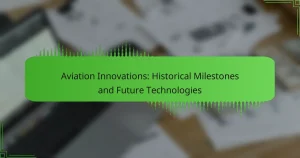Urban Air Mobility promises to reduce traffic congestion and enhance urban accessibility, yet it faces challenges such as regulatory hurdles and safety concerns. Key concepts include technological advancements like eVTOL aircraft, infrastructure development with vertiports, and the importance of public acceptance. This article explores the benefits of Urban Air Mobility, the challenges ahead, and the emerging technologies shaping its future. Understanding these elements is crucial for cities aiming to integrate innovative air transportation solutions.

What are the key concepts driving Urban Air Mobility?
Key concepts driving Urban Air Mobility include technological advancements, regulatory frameworks, infrastructure development, and public acceptance. These elements collectively shape the future of air transportation in urban environments.
Technological advancements focus on electric vertical takeoff and landing (eVTOL) aircraft, which offer greater efficiency and reduced emissions. Regulatory frameworks aim to establish safety standards and air traffic management systems to integrate urban air mobility into existing infrastructures.
Infrastructure development encompasses vertiports and charging stations, essential for supporting eVTOL operations. Public acceptance is crucial, as it influences the adoption of urban air mobility solutions and addresses concerns regarding noise, safety, and cost.
These concepts highlight the multifaceted approach required to realize the potential of urban air mobility while addressing challenges such as environmental impact and operational feasibility.
How do technological advancements influence Urban Air Mobility?
Technological advancements significantly enhance Urban Air Mobility (UAM) by improving efficiency, safety, and accessibility. Innovations in electric propulsion and autonomous flight systems reduce operational costs and environmental impact. Enhanced air traffic management systems facilitate seamless integration into existing infrastructures. As a result, UAM can provide quicker, more reliable transportation options in urban areas.
Which stakeholders are involved in Urban Air Mobility initiatives?
Key stakeholders in Urban Air Mobility initiatives include government agencies, private companies, research institutions, and community organizations. Each entity plays a vital role in shaping policies, developing technologies, and addressing public concerns.
Government agencies oversee regulatory frameworks and airspace management. Private companies contribute through innovation and investment in aerial vehicles and infrastructure. Research institutions provide essential data and technological advancements. Community organizations advocate for public interests and safety in urban environments.
Collaboration among these stakeholders is crucial for the successful implementation of Urban Air Mobility solutions. Their collective efforts can enhance transportation efficiency and reduce congestion in urban areas.
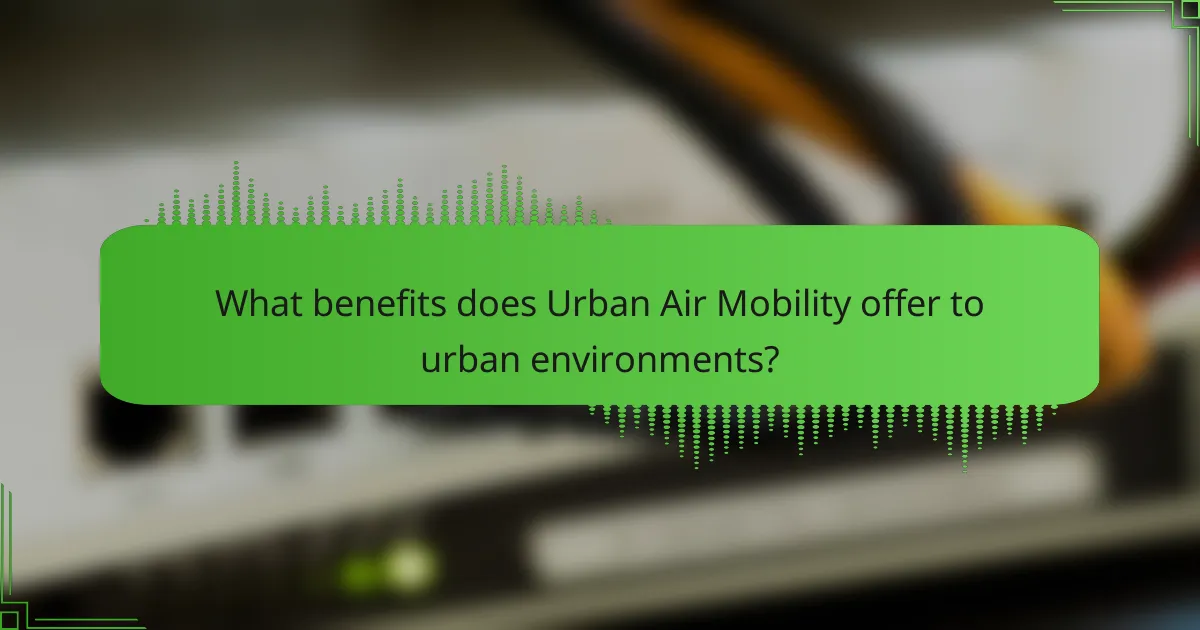
What benefits does Urban Air Mobility offer to urban environments?
Urban Air Mobility offers significant benefits to urban environments, including reduced traffic congestion, lower emissions, and enhanced accessibility. These innovations can lead to improved air quality and shorter commute times. Urban Air Mobility can also stimulate economic growth by creating jobs in new sectors. As cities adopt these technologies, they can transform urban landscapes and enhance overall quality of life.
How can Urban Air Mobility alleviate traffic congestion?
Urban Air Mobility can significantly alleviate traffic congestion by providing an alternative transportation method that bypasses ground-level bottlenecks. This innovative approach allows for quicker travel times and reduced vehicle density on roads. For example, urban air vehicles can operate on predefined routes, minimizing delays caused by traditional traffic signals and accidents. As a result, cities could see a notable decrease in commute times, enhancing overall mobility and efficiency.
What environmental advantages does Urban Air Mobility present?
Urban Air Mobility offers significant environmental advantages, including reduced traffic congestion and lower greenhouse gas emissions. By utilizing electric vertical takeoff and landing (eVTOL) aircraft, Urban Air Mobility can minimize reliance on traditional ground transportation, leading to cleaner air quality. Additionally, efficient routing and flight paths can decrease energy consumption compared to conventional vehicles.
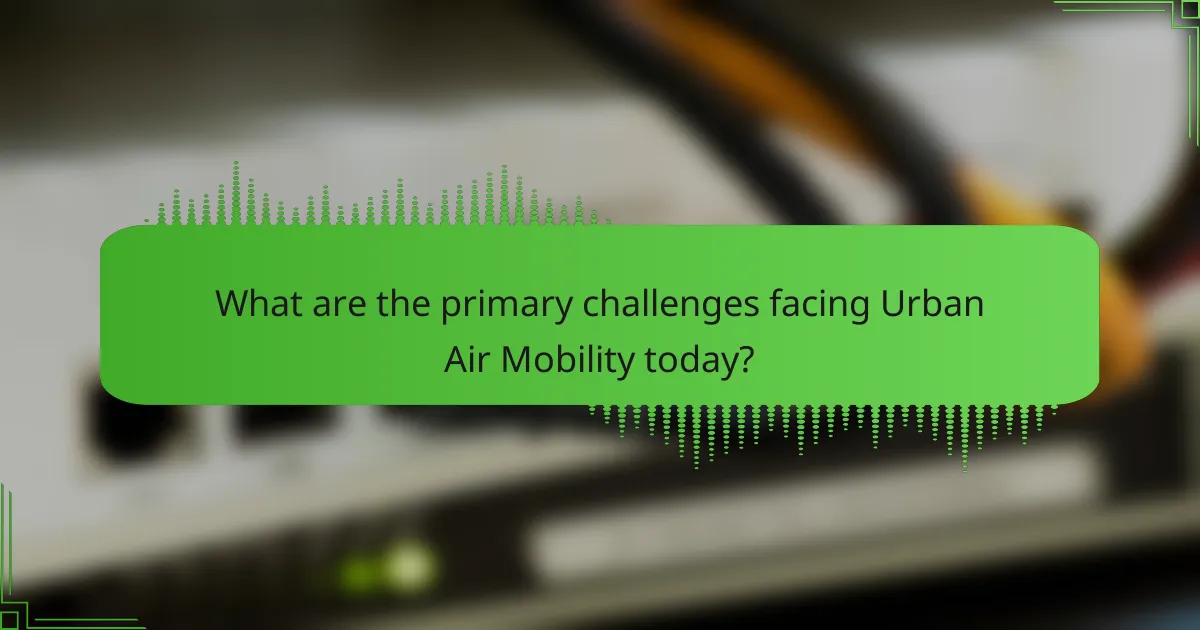
What are the primary challenges facing Urban Air Mobility today?
Urban Air Mobility faces several primary challenges today, including regulatory hurdles, safety concerns, and infrastructure limitations. Regulatory frameworks are still evolving, which complicates the integration of air vehicles into existing airspace. Safety remains a critical issue, as public acceptance hinges on the reliability of these systems. Infrastructure development is also lagging, with the need for vertiports and maintenance facilities not yet fully addressed. These challenges must be overcome to realize the potential of Urban Air Mobility.
How do regulatory hurdles impact Urban Air Mobility development?
Regulatory hurdles significantly delay Urban Air Mobility development by imposing strict safety and operational standards. These regulations ensure public safety but complicate the integration of aerial vehicles into existing airspace systems. For instance, certification processes can take years, hindering innovation and market entry. As a result, companies often face increased costs and extended timelines, which can stifle competition and slow technological advancements.
What are the safety concerns associated with Urban Air Mobility?
Safety concerns associated with Urban Air Mobility include air traffic management, noise pollution, and potential accidents. These factors can impact urban infrastructure and public perception. Effective regulation and technology solutions are crucial for addressing these challenges.
Key concerns include:
– Air Traffic Management: Ensuring safe integration into existing airspace.
– Noise Pollution: Minimizing disturbance to urban populations.
– Technical Failures: Addressing risks of system malfunctions.
– Pilot Training: Ensuring operators are adequately trained for safety.
– Emergency Protocols: Establishing clear procedures for incidents.
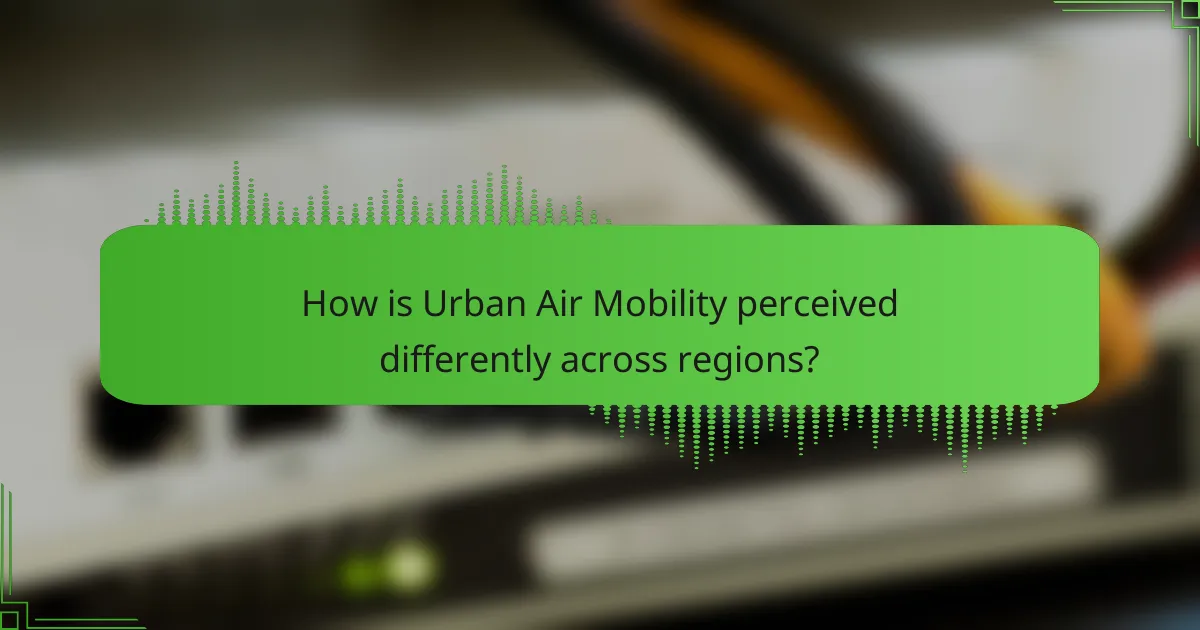
How is Urban Air Mobility perceived differently across regions?
Urban Air Mobility is perceived variably across regions due to cultural, economic, and regulatory factors. In North America, there is significant enthusiasm driven by technological innovation and investment. Conversely, Europe focuses on regulatory frameworks and environmental sustainability, impacting public acceptance. In Asia, rapid urbanization fuels demand, but safety concerns and infrastructure readiness pose challenges. Each region’s unique attributes shape its approach to Urban Air Mobility, influencing its future development.
Which regional case studies highlight successful Urban Air Mobility implementations?
Several regional case studies demonstrate successful Urban Air Mobility implementations. In the United States, the city of Los Angeles has initiated a project focusing on air taxis to alleviate traffic congestion. In Europe, the city of Paris is testing drone delivery services to enhance logistics efficiency. Singapore has launched a pilot program for air taxis, aiming to improve urban transport. In Japan, the city of Tokyo is developing a comprehensive air mobility strategy, integrating drones for cargo and passenger transport. These examples highlight innovative approaches to urban transport challenges through aerial solutions.
What cultural attitudes towards Urban Air Mobility exist in various markets?
Cultural attitudes towards Urban Air Mobility vary significantly across markets, influenced by factors like technology acceptance and regulatory frameworks. In North America, there is a generally optimistic outlook, driven by innovation and investment in infrastructure. European markets express cautious enthusiasm, focusing on sustainability and integration with existing transport systems. In contrast, Asian markets exhibit a mix of rapid adoption and regulatory challenges, reflecting diverse urban planning approaches. Public perception often hinges on safety concerns and environmental impact, shaping the pace of implementation.
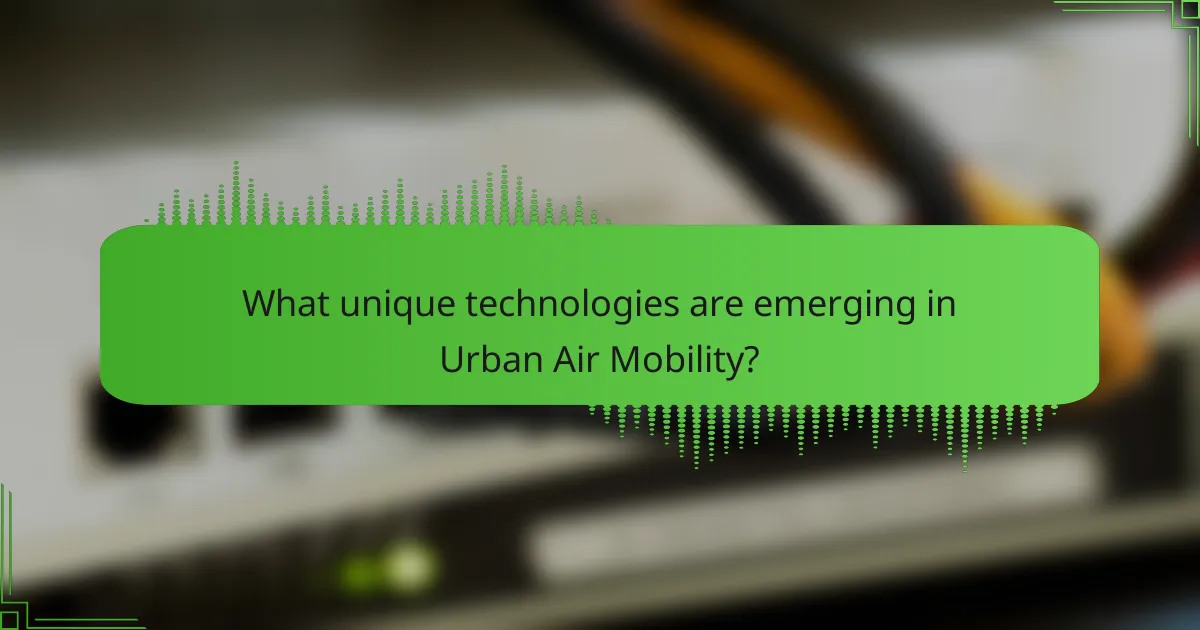
What unique technologies are emerging in Urban Air Mobility?
Emerging technologies in Urban Air Mobility include electric vertical takeoff and landing (eVTOL) aircraft, advanced air traffic management systems, and autonomous flight systems. These innovations enhance safety, efficiency, and scalability in urban environments. eVTOL aircraft, for instance, offer reduced noise and emissions compared to traditional helicopters, making them suitable for city operations. Advanced traffic management systems utilize AI to optimize flight paths, reducing congestion. Autonomous systems enable pilotless flights, streamlining operations and lowering costs. As a result, these technologies are poised to transform urban transportation.
How do electric vertical takeoff and landing (eVTOL) aircraft differ from traditional aircraft?
eVTOL aircraft differ from traditional aircraft primarily in their design and operational capabilities. eVTOLs utilize electric propulsion, enabling vertical takeoff and landing, which allows them to operate in urban environments with limited space. Traditional aircraft generally require longer runways and rely on conventional fuel sources.
eVTOLs are designed for short-distance urban travel, making them more efficient for commuting compared to traditional aircraft, which are optimized for longer distances. The noise levels of eVTOLs are generally lower, addressing urban noise pollution concerns, while traditional aircraft can be significantly louder during takeoff and landing.
In terms of sustainability, eVTOLs offer reduced emissions due to their electric nature, aligning with environmental goals. Traditional aircraft, in contrast, contribute to higher carbon footprints. The development of eVTOL technology represents a unique shift in aviation, aiming to enhance urban air mobility and reduce congestion on roads.
What innovations are shaping the future of Urban Air Mobility?
Innovations shaping the future of Urban Air Mobility include electric vertical takeoff and landing (eVTOL) aircraft, advanced air traffic management systems, and autonomous flight technologies. These developments aim to enhance efficiency, reduce congestion, and improve safety in urban transportation. eVTOLs, for example, offer a sustainable alternative to traditional aircraft, with many designs featuring zero-emission capabilities. Advanced traffic management systems will integrate urban air vehicles into existing airspace, ensuring seamless operations. Furthermore, the adoption of autonomous flight technologies could significantly lower operational costs and increase accessibility.
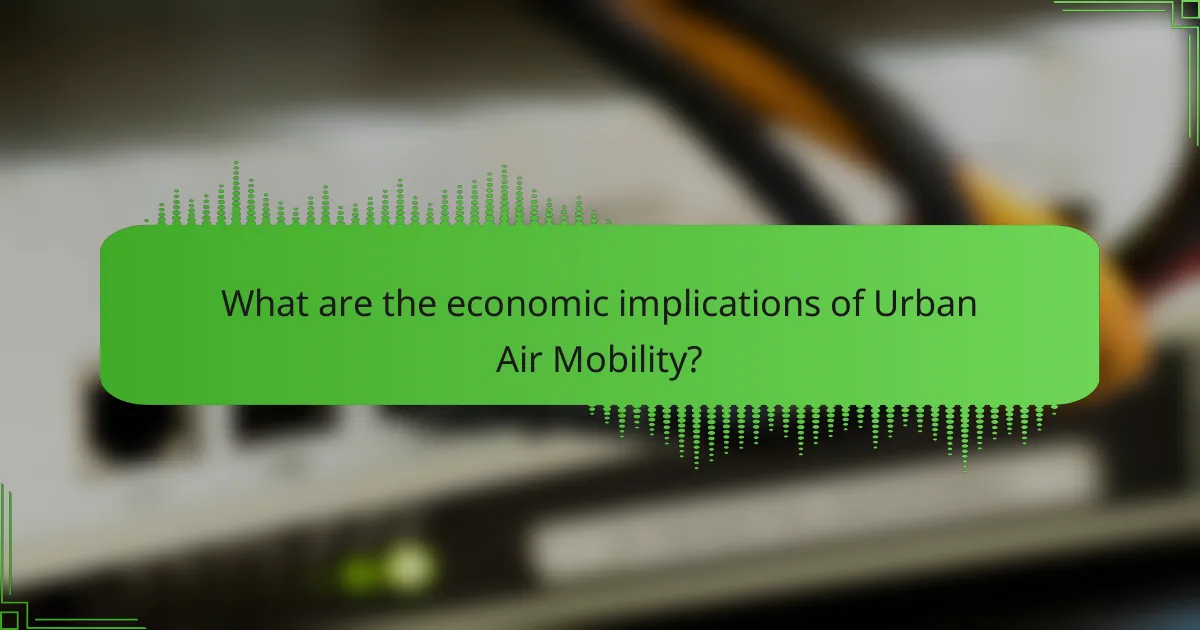
What are the economic implications of Urban Air Mobility?
Urban Air Mobility has significant economic implications, including job creation, infrastructure development, and reduced transportation costs. It can enhance urban connectivity, leading to increased productivity and economic growth. For instance, the integration of aerial vehicles could reduce congestion, saving time and resources. Furthermore, the urban air mobility market is projected to reach $1.5 trillion by 2040, demonstrating its potential to reshape economies. The transition requires investment in technology and regulatory frameworks, which will also drive innovation in related sectors.
How can Urban Air Mobility create new job opportunities?
Urban Air Mobility can create new job opportunities by fostering innovation and expanding industries. This sector will require skilled workers in engineering, manufacturing, and operations. Additionally, it will generate jobs in maintenance, air traffic management, and regulatory compliance. As cities adopt these technologies, support roles in logistics and customer service will also grow. The unique nature of Urban Air Mobility, focusing on aerial transport solutions, distinguishes it from traditional transportation sectors.
What investment trends are emerging in the Urban Air Mobility sector?
Investment trends in the Urban Air Mobility sector include increased funding for electric vertical takeoff and landing (eVTOL) aircraft, advancements in autonomous flight technology, and partnerships between aerospace companies and tech startups. These trends reflect a growing interest in sustainable urban transportation solutions. As cities face congestion, Urban Air Mobility presents a unique opportunity to alleviate traffic issues and improve accessibility. Recent estimates predict that the market could reach $1 trillion by 2040, highlighting its potential impact on urban infrastructure.
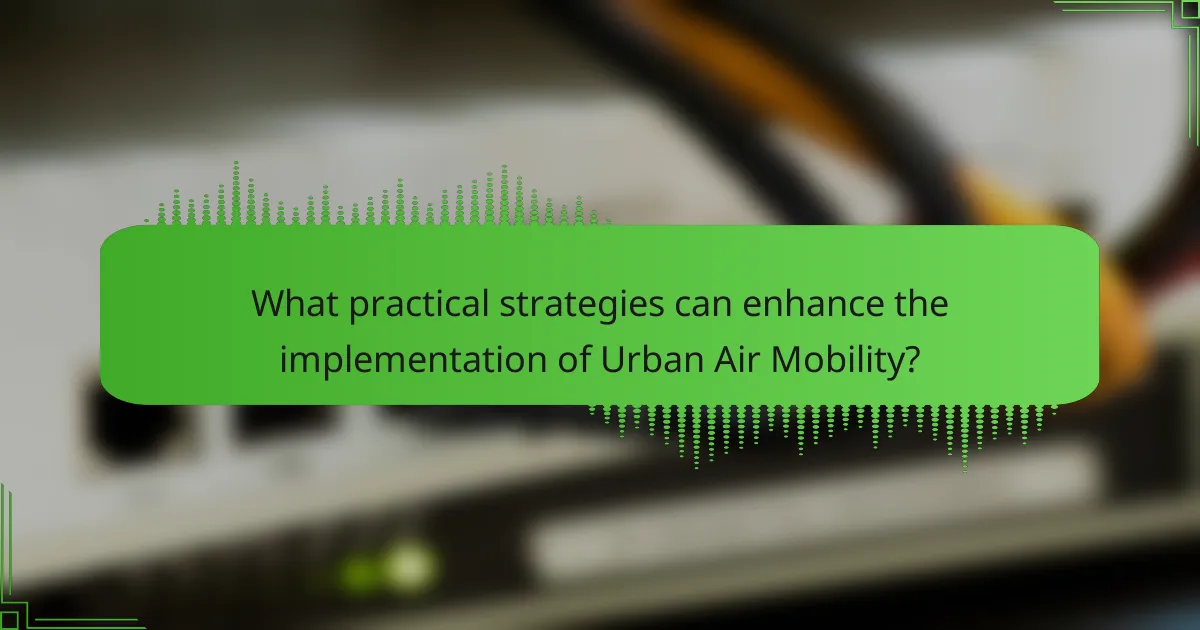
What practical strategies can enhance the implementation of Urban Air Mobility?
Implementing practical strategies can significantly enhance Urban Air Mobility. Key strategies include developing regulatory frameworks, investing in infrastructure, and fostering public-private partnerships.
1. Establish clear regulations to ensure safety and efficiency in airspace management.
2. Build vertiports and charging stations to support electric vertical takeoff and landing (eVTOL) aircraft.
3. Promote collaboration between government agencies, private companies, and communities for seamless integration.
4. Conduct public outreach to educate citizens on the benefits and safety of Urban Air Mobility.
5. Invest in research and development to advance technology and reduce costs associated with Urban Air Mobility.
These strategies address challenges and promote effective implementation.
Which best practices should urban planners consider for Urban Air Mobility integration?
Urban planners should prioritize safety, regulatory frameworks, and infrastructure development for Urban Air Mobility integration. Effective air traffic management systems are essential to ensure safe operations. Collaboration with stakeholders, including local communities and technology providers, enhances acceptance and efficiency. Planners must also consider noise pollution and environmental impacts to create sustainable urban air transport solutions.
What common pitfalls should be avoided in Urban Air Mobility projects?
Common pitfalls in Urban Air Mobility projects include underestimating regulatory challenges, neglecting public acceptance, overlooking infrastructure needs, and failing to integrate with existing transportation systems. Addressing these factors is crucial for successful implementation.
